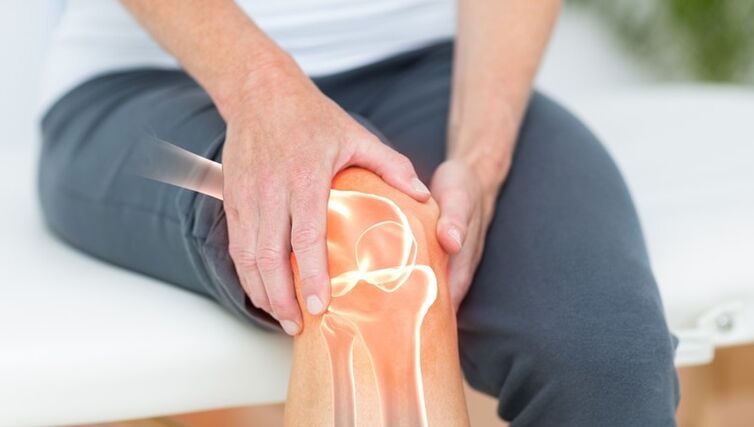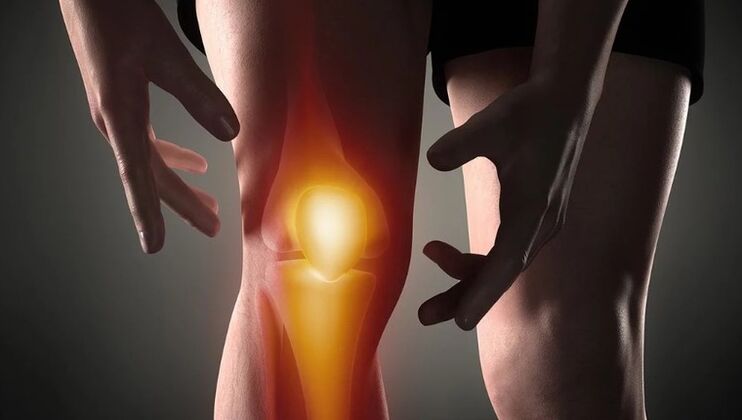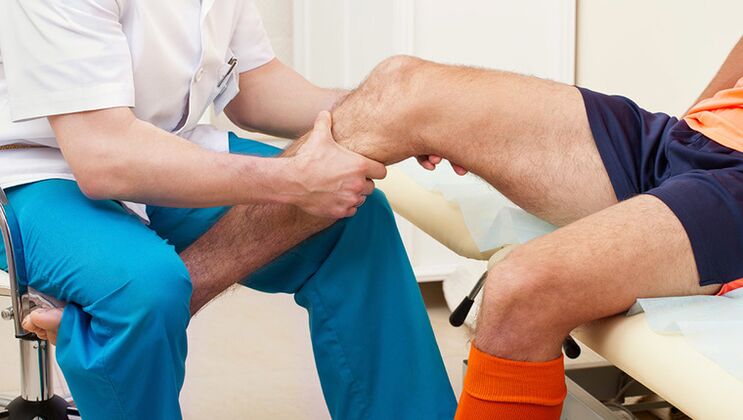The knee joint is one of the most complex joints in the human body.Systematic load causes everyone to experience joint pain that is dull, aching, or sharp, and sometimes unbearable at least once in their life.It can occur when walking and moving the knee, and can also be a constant concern.The nature of pain in the knee joint and the source of its occurrence are very diverse.

The structure of the knee joint
As the largest joint element in the human body, the knee joint is always subject to sports injuries.Bones, cartilage, tendons, ligaments, meniscus and periarticular capsule - if these parts are injured, they will definitely cause pain in the knee.
The bone composition of the knee joint includes:
- Shin (Tibia).This is the main weight-bearing bone connected to the lower part of the femur;
- Femur (femur), which is the longest and strongest bone and is connected to the knee and tibia;
- Patella, which is located at the bottom of the thigh.Together with the femur it forms the patellofemoral joint.
The junction of the femoral notch and the knee contains cartilage, which allows these bones to maintain a healthy state of motion relative to each other, eliminating friction and pain in the knee.
The muscles of the knee joint include the hamstrings and the quadriceps muscles:
- The posterior femoral surface muscle group consists of four heads located in its anterior part.These are rectus femoris, vastus lateralis, vastus medialis and vastus intermedius.They are attached to the joint by tendons.By contracting the quadriceps muscle, the lower leg is extended and the leg is straightened.
- The posterior femoral surface muscle group consists of three muscles, the contraction of which contributes to the flexion of the lower leg.These are the biceps, semimembranosus and semitendinosus muscles.
There are two main types of cartilage in the knee joint:
- Hyaline cartilage promotes less friction because it is strong and flexible.
- The medial and lateral menisci are cartilaginous structures that act as "air bags" to provide cushioning between bones that are in contact.
The knee joint includes ligaments in the form of fibers made up of connective tissue.
Ligaments connect bones to each other:
- The tibia and femur are connected by the anterior cruciate ligament.It helps prevent the tibia from moving forward relative to the femur.
- The role of the posterior cruciate ligament is to prevent posterior movement of the tibia relative to the femur.
- On the outside of the knee are the external collateral ligaments.It connects the fibula and femur and helps limit forces and stabilize the knee joint.
- The lower edge of the femur is connected to the upper edge of the tibia by the internal collateral ligament, which stabilizes the joint and prevents unwanted movement.
Tendons attach muscles to bones.
Tendons are divided into the following types:
- At the back of the knee joint is the tendon of the hamstring muscle.
- The quadriceps tendon is attached to the top of the cup.
- The region below the knee is attached to the top of the tibia via the hamstring tendon.
The nature of the pain depends on the location
Pathological changes in the joints depend directly on the location of the pain.Pain, as an indicator, indicates discomfort and changes in the joints.
That is:
- With arthritis, acute bursitis, meniscal rupture, severe pain occurs;
- with early bursitis and synovitis - tolerable but persistent pain;
- Gonarthrosis and arthrosis accompanied by pinching pain;
- with degenerative arthrosis with joint deformation - vibrating pain;
- With bone tuberculosis and damage to the sciatic nerve, the pain is acute;
- Injury to the Menisci, osteoporosis, inflammation of the synovial bursa accompanied by stinging pain in the knee joint;
- Inflammation in the tendons and muscle tissue of the joint causes cramping pain;
- When the nerve root is damaged, shooting pain occurs.
Causes of pain in the knee joint
Medical statistics show that knee pain syndrome is caused by the presence of an inflammatory process in the knee.
Sources can be very different:
- 50% of pain conditions are associated with arthrosis, as a result of which hyaline cartilage is slowly destroyed.Sometimes the disease is asymptomatic, getting worse only in the second stage.Due to the growth of osteophytes and their impact on the nerves on joint sensation, discomfort may appear.
- Often joints can be affected by arthritis, both as an independent disease and as a complication in the form of rheumatism and arthrosis.Arthritis is characterized by severe pain, swelling and redness of the knee.
- Pain can occur with osteochondritis, when articular cartilage becomes inflamed due to degenerative arthrosis or mechanical trauma.
- The result of obesity is often periarthritis, which affects the tendons, muscles, and sometimes the lining of the joints.This disease is accompanied by pain.
- With bursitis, inflammation of the synovial capsule occurs as a result of injury or complications of other diseases of the knee joint.
- With chondromatosis, nodules form in areas of hyaline cartilage, which then spread throughout the joint.Soft tissue with a large number of nerve cells is pinched, and pain occurs.
- Pain may appear with cellulitis if the focus of other concomitant diseases (purulent arthritis, soft tissue abscess) is located close to fatty tissue under the skin.
- With dermatitis, damage to the epidermis occurs due to eczema, erysipelas, allergic reactions, and psoriasis.
- Synovitis is characterized by damage to the joint capsule due to chronic pathological changes.This disease develops in elderly people over fifty-five years old.At a young age, this disease can occur as a result of severe injuries.
- The pain occurs as a result of osteomyelitis, which is characterized by bacterial inflammation of the bone marrow.This disease can be caused by complications during surgery or from open injuries.

What to do if your knee joint hurts badly
After identifying the cause of joint pain, it is necessary to start pathological treatment.The most effective treatment is medication, because conservative therapy can help with the onset of destructive changes in the body.If you do not see a doctor in time, you need to resort to surgical intervention.
Often, knee pain begins suddenly, and a person does not know how to behave in such a situation.If it is not possible to immediately contact a specialist, it is necessary to take immediate measures to relieve pain and swelling.
What activities will help with this:
- It is necessary to suspend any activity, lie down with a pillow under your knees;
- For swelling, you need to use cold compresses (ice, cold objects) for 15-20 minutes 4-5 times a day;
- If two days have passed after the treatment procedure and the pain has decreased significantly, you can start exercises to restore joint flexibility.A short massage (5-10 minutes) is possible;
- To combat pain after an impact on the knee, you need to wrap it with an elastic bandage (or use a knee brace) to maintain the accuracy of the joint;
- Even if you overcome the pain for several weeks after the injury, you must treat the injured limb with care, move less, and give up vigorous activities.
To relieve pain in the knee joint, you can continue conservative treatment.The most common drugs recommended by doctors are non-steroidal anti-inflammatory drugs in the form of gels, ointments and tablets.
Conservative treatment is often supplemented with physiotherapy procedures.Manual therapy is very effective, with the help of which you can heal damage to ligaments, meniscus, and arthrosis at an early stage.
In cases where conservative treatment of the knee joint is impossible, experts recommend surgical intervention.Torn ligaments, meniscus, broken bones - such injuries are restored with the help of serious operations.
Diagnostics
Early diagnosis allows successful treatment of knee joint disease and eliminates the risk of developing a serious process.Initial consultation with a therapist will help in determining the direction of examination and referral to a specialist.
Pain sensations are studied in several directions:
- In surgery.CT, MRI, ultrasound, fluoroscopy, blood tests for the presence of rheumatoid factor, puncture of the hyaline cartilage of the knee joint are used.
- In traumatology.Examinations are recommended using X-rays, ultrasound, MRI, and liquid biopsies in the synovial bursa.
- In Rheumatology.General laboratory tests are carried out in the form of blood tests for the presence of rheumatoid protein, hematology, and uric acid levels.DNA testing is used.
- In psychiatry and neurology.Ultrasound allows you to diagnose pinched muscles and nerves.For so-called somatic pain in patients with mental disorders, a special examination is prescribed for the presence of mental illness.

Treatment of Joint Diseases of the Knee
People's recovery
You can turn to traditional medicine after an accurate diagnosis, and be sure to consult your doctor.It is impossible to completely cure knee disease using traditional methods, but traditional medicine will help relieve pain and inflammation, and can also act as maintenance therapy.
Rubs and ointments are considered effective folk remedies:
- Egg yolk ointment.The yolk is mixed together with a spoonful of turpentine and a spoonful of apple cider vinegar.Helps relieve joint pain and inflammation;
- 300 g of horse chestnut kernels are crushed and placed in a bottle of vodka.This mixture is infused for two weeks (it is necessary to shake the infusion).
Used to rub before bed.The knee joint is also treated with compression.
For this type of treatment, medicinal plants and vegetables are used:
- Rinse 7-8 Burdock leaves thoroughly, wipe dry, fold and press with a bowl of boiling water to release healing phytoncides.Then put the steamed leaves on the knees that were previously cooled with vegetable oil, wrap them in cling film, and cover them with gauze or a soft cloth.The compress is kept for several hours.
- Peel the raw potatoes, grate them on a coarse grater, and heat them a little in a water bath.Place the puree in a natural cloth bag.This bag is placed on the knee and left overnight.Treatment is carried out within a week.You should remember to prepare new contents of the bag every day.
- To relieve pain and stop the inflammatory process in the knee, Celandine is used.It is necessary to soak a linen cloth with plant juice, wrap it around the knee and cover it with a film.The compress should be kept for about 50 minutes, after which the knee should be treated with sunflower oil.The weekly procedure must be carried out three times with a 10-day break.
Traditional medicine
Knee joint disease has many common manifestations in the form of long-lasting pain, difficulty moving, swelling, deformation and inflammation of the knee.Arthritis, arthrosis, and bursitis are characterized by inflammatory processes and swelling of the knee joint, often with increased body temperature.
Arthritis and arthrosis are treated with the use of non-steroidal anti-inflammatory drugs.During therapy, a prerequisite is the normalization of metabolism and the removal of salts with the help of several drugs, as well as the establishment of an optimal acid-base balance.When treating arthritis and arthrosis, you must follow the instructions of a specialist to achieve sustainable positive dynamics.
The treatment of tendonitis and bursitis is aimed at anti-inflammatory therapy and creating a resting position for the affected limb.To relieve pain, a puncture of the joint capsule is performed to remove accumulated fluid and administer antibiotics.In severe cases, surgery is indicated.
Therapeutic measures for dystrophic lesions of the knee joint (meniscopathy, tendinopathy, chondropathy) aim to relieve knee pain, treat and restore healthy joint function.But in this case, if there is no therapeutic effect, surgery is prescribed.
Preventive measures
Prevention of knee joint disease allows you to avoid wear, injury, inflammation, helps maintain their health and protects them from complications.Regular preventive measures effectively help to prevent the process of pain and inflammation and prevent the development of the disease.
What steps should be taken to protect against knee joint disease:
- Follow safety rules to avoid knee injuries;
- proper physical activity;
- maintain a normal weight;
- watch diet and fluid intake;
- fight any infection in time;
- Contact a specialist in time to treat joint diseases.
If there is a systemic disease that affects the function of the knee joint, the most optimal preventive measure will be timely and adequate treatment.Only in this way can damaging processes in joint tissues be prevented.With the complex therapy of knee joint diseases, the use of anti-inflammatory drugs, physiotherapy, therapeutic exercises and other therapeutic and health technologies, as well as following the right diet and physical activity, it is possible to ensure the healthy function of the joint and definitely ensure the joy of movement and active, fulfilling life.


















